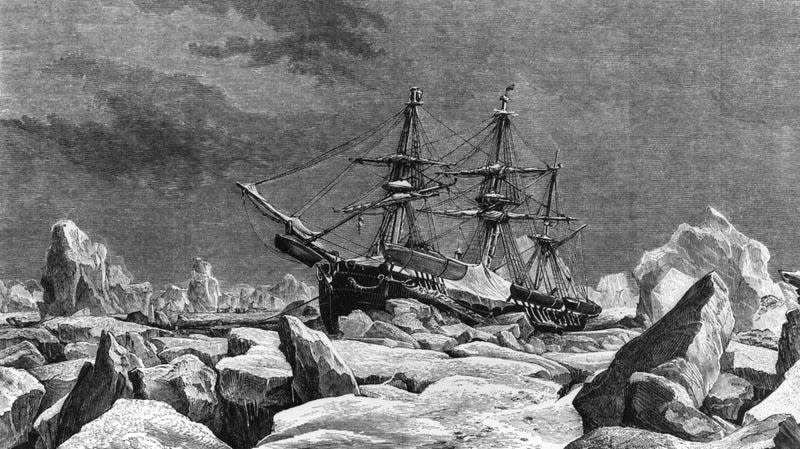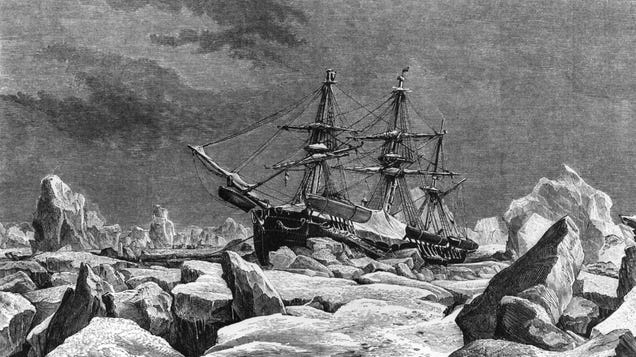
I am fascinated by both Antarctic And Arctic exploration; nowhere else on earth do people want to die like the poles of our planet, but people still manage to make a living in both places. While human populations in Antarctica are limited to visiting researchers, people have been living in the frozen north for some time. For the locals in the Arctic, this used to mean the chance toreckless European explorers in desperate situations.
While reading about the disastrous Franklin Expedition of 1845, I came across an old story of the National Post about what the Inuit experienced when the starving, half-mad crews left their gigantic stranded sailing ships in the ice to search for rescue.
When HMS Terror and Erebus were first launched in 1845, most of the passage had already been fully charted. All that remained was to find the final stretch of the route. The ships spent a year and a half searching the Arctic Ocean as their crews of 134, led by Sir John Franklin, searched for the Northwest Passage, a near-mythical route that would allow Europeans to sail to the Pacific without having to go all the way around the South American content or the traditional route around the Cape of Good Hope in Africa. When the crews of HMS Terror and Erebus were trapped by incredibly thick ice in September 1845, no one panicked.
When the ice failed to thaw that summer, there was still little cause for alarm. The ships were provisioned for three years thanks to a new technology: canned food. By April 1848, however, Sir Franklin was dead, and the remaining crew abandoned their ships to walk an impossible 800 miles to the nearest whaling station. Their supposedly long-lasting provisions had been contaminated by defective lead solder. This led to spoilage, increasing the risk of botulism and creating a shortage of provisions that were supposed to last three years. What did not spoil became poisonous due to the lead solder. Scurvy was also beginning to set in by the time the crew began walking, attempting to cross the entire length of King William Island, a barren stretch of ice and gravel.
Once they were spotted by Inuit people, most of whom had heard of Europeans but had never seen a white person, the crew seemed like a real-life zombie apocalypse. It was so shocking that Inuit people still tell the story today, nearly 180 years later, according to the Post:
Inuit nomads had encountered waves of men who “didn’t seem right.” Maddened by scurvy, botulism, or despair, they raved in a language the Inuit couldn’t understand. In one case, hunters came across two survivors of the Franklin expedition who had been sleeping for days in the hollowed-out bodies of seals.
“They were unrecognizable, they were so dirty,” Taloyoak resident Lena Kingmiatook told Eber.
Mark Tootiak, a stepson of Nicholas Qayutinuaq, told Eber a story about a group of Inuit who early on encountered a small and “hairy” group of Franklin expedition members evacuating south.
“Later … these Inuit heard that people had seen more white people, many more white people, dying,” he said. “They were seen with human flesh.”
Even Eber’s translator, the late Tommy Anguttitauruq, told of a goose-hunting trip where he came across a skeleton from the Franklin expedition still carrying a clay pipe.
By 1850, the bays and beaches around King William Island were littered with the disturbing remains of their advance: garments and camps still strewn with their dead occupants. Decades later, researchers would confirm Inuit stories of cannibalism when they found bleached human bones with their flesh hacked clean.
“I never saw a ghost in my life. I’ve heard the sounds they make, but I’ve never seen one with my own eyes,” said the old man who had gone out to investigate the Franklin survivors who had invaded his camp on King William Island that day.
Shuffling, pale creatures that felt cold, that seemed to shuffle along unconsciously and eat each other? Yeah, that sounds like zombies to me. The Inuit who came across some of the survivors did their best to help, but they were also terrified. The Inuit left three seals to eat, built an igloo and a fire for the desperate men… and then got away as quickly as they could. Who could blame them? When the Inuit returned months later, they found the remains of a horror show:
The Inuit had left so quickly that they had left several belongings behind. When a small party returned to camp to retrieve them, they found an igloo full of corpses.
The seals were untouched. Instead, the men had eaten each other.
It would cause a scandal in the United Kingdom when the first evidence emerged of what had happened to Franklin’s men.
The British would launch rescue missions in 1848, far too late to save the doomed crew. It was not until a decade later, when Scottish explorer John Rae returned from an 1854 Arctic voyage, that the public received any news of the extent of the Franklin expedition’s suffering. However, when cannibalism was discussed, people dismissed the testimony of the local Inuit tribes, choosing to believe that honorable British men would never stoop to eating each other. Modern evidence confirms that these sincere British explorers did indeed resort to eating each other in their final moments, Smithsonian Magazine explains:
And now, a new analysis of 35 bones by anthropologists Simon Mays and Owen Beattie suggests that the men did indeed eat each other. The bones they analyzed showed signs of fracture and heating, so the crew probably boiled them to extract the marrow. Mays and Beattie published their results on June 18 in the International Journal of Osteology.
In 2014, explorers found the remains of the HMS Erebus, and the wreck of the Terror was found two years later just off the coast of King William Island. The location of the Terror was discovered thanks to, you guessed it, an Inuit fisherman who spotted part of the mast sticking out of the gravel on the island’s shore.







